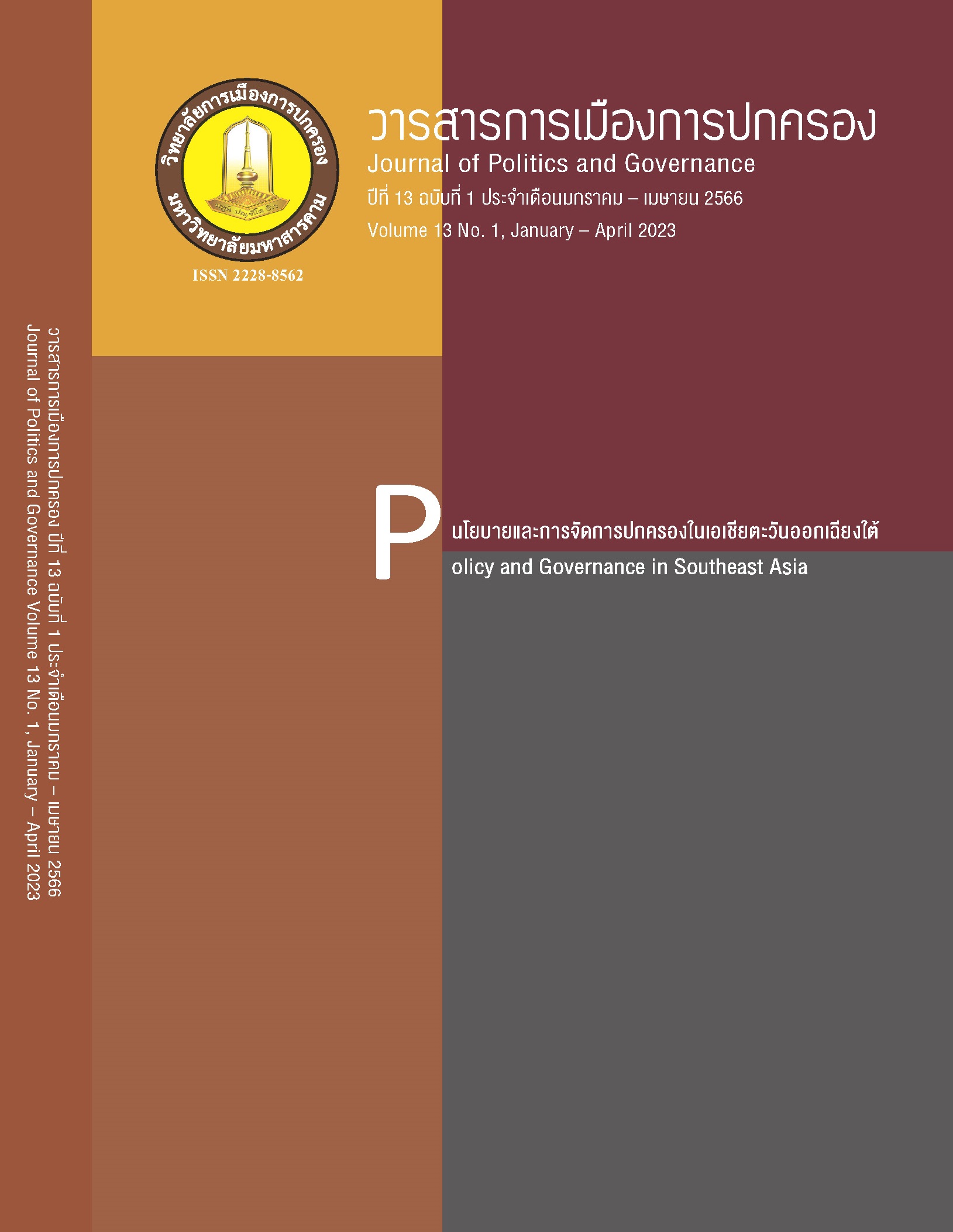Social Capital: Creative Community Based Tourism Management Case study of the Ancient city of Wiang Sa, Wiang Sa District SuratThani Province
Main Article Content
Abstract
This research was to study 1) the social capital that appeared in the Wiang Sa Ancient Community, 2) the role of social capital in the creative tourism management of the Wiang Sa Ancient Community, and 3) the creative tourism management process of the Wiang Sa Ancient Community. The qualitative research employed in-dept interview to gain the data from key person informants: villagers, folk leaders, villagers, community network groups, a local leader, and volunteer graduates in the area. Descriptive and content analysis methods were used to analyze the data and lead to summary and recommendations. The results showed that social capital can classify into 1) the ancient city of Wiang Sa, 2) the traditions, 3) Manora, Phonchit (local folk dance group), and 4) folk masters on various wisdom such as religious rituals/occultism, and traditional massage which have been permanently accumulated as their own cultural heritage and wisdom and created closely connection between people within community itself and learning links with outsiders. There is a network to support and promote knowledge expansion and communicate outside. Thus, applying the natural and man-made social capital is a bridge to promote a community's creative tourism and can increase value added. The 5-Step creative tourism management process from this study can organize under 1) selection of creative tourism activities, 2) knowledge development of each activity 3) experiment for creative tourism activities 4) qualified tourism activities promotion and 5) evaluation for tourism activities. The result leads to a proposal providing the community with tourism management skills and knowledge to give the right information to tourist under the strategic plan for promoting tourism and creating participatory within community, and outside partners.
Article Details
References
กระทรวงการพัฒนาสังคมและความมั่นคงของมนุษย์. (2549). ระบบการพัฒนาสังคมที่นำไปสู่ความมั่นคงของมนุษย์. กรุงเทพฯ: เทพเพ็ญวานิสย์.
เขมชาติ เทพไชย. (2527). รายงานการสำรวจขุดค้นทางด้านโบราณคดีบริเวณเมืองโบราณเวียงสระ อำเภอเวียงสระ จังหวัดสุราษฎร์ธานี. กรมศิลปกร: โครงการโบราณคดีประเทศไทย (ภาคใต้).
คัชพล จั่นเพชร, และพิทักษ์ ศิริวงศ์. (2017). การบูรณาการทุนทางวัฒนธรรมสู่การเป็นแหล่งท่องเที่ยวเชิงสร้างสรรค์ ด้วยกระบวนการมีส่วนร่วมของชุมชน: กรณีศึกษา ชุมชนบ้านชากแง้ว อำเภอบางละมุง จังหวัดชลบุรี. วารสารการวิจัยเพื่อพัฒนาชุมชน (มนุษยศาสตร์และสังคมศาสตร์), 10(1), 111-121.
จงจิตร อภิชาตกุล. (2563, 27 พฤษภาคม ). ผู้ใหญ่บ้าน หมู่ที่ 7 [บทสัมภาษณ์].
จิราภรณ์ แก้วเจริญ. (สัมภาษณ์ 25 พฤษภาคม 2563). ศูนย์พัฒนาเด็กเล็กเทศบาลตำบลเมืองเวียง [บทสัมภาษณ์].
จิราพร ไชยเชนทร์, ธีรศักดิ์ อุ่นอารมย์เลิศ, และไชยยศ ไพวิทยศิริธรรม. (2560). การพัฒนารูปแบบการประยุกต์ใช้ทุนทางสังคมเพื่อส่งเสริมการท่องเที่ยว คลองร้อยสายเชิงสร้างสรรค์. วารสาร Veridian E-Journal, Silpakon University. ฉบับภาษาไทย มนุษยศาสตร์ สังคมศาสตร์ และศิลปะ, 10(2), 2039-2053.
เจิมขวัญ ศรีสวัสดิ์, และชีวัน ขวัญธรรม. (2561). เส้นทางสู่… ศูนย์พัฒนาเด็กเล็กต้นแบบด้านความปลอดภัยทางถนน. กรุงเทพฯ : สำนักงานกองทุนสนับสนุนการสร้างเสริมสุขภาพ (สสส.).
ดาริน วรุณทรัพย์. (2561). รูปแบบการจัดการทุนทางวัฒนธรรมเพื่อการท่องเที่ยวเชิงสร้างสรรค์ในประเทศไทย. (วิทยานิพนธ์ปรัชญาดุษฎีบัณฑิต). มหาวิทยาลัยราชภัฏราชนครินทร์, ฉะเชิงเทรา.
นิตยา ปรูกระโทก. (2558). การสะสมทุนทางสังคมสู่การสร้างเสริมสุขภาวะชุมชน. วารสารวิถีสังคมมนุษย์, 3(2), 238-256.
พรจิตร ชูชื่น. (2563, 24 มิถุนายน). ครูภูมิปัญญา [บทสัมภาษณ์].
วรวุฒิ โรมรัตนพันธ์. (2548). ทุนทางสังคม. กรุงเทพฯ: โครงการสร้างเสริมการเรียนรู้เพื่อชุมชนเป็นสุข (สรส.).
รัตตพล สุวรรณโชติ, และคณะ. (2558). โครงการแนวทางการพัฒนาพิพิธภัณฑ์ท้องถิ่นเมืองเวียงสระเพื่อสร้างสำนึกรักท้องถิ่นอย่างมีส่วนร่วมระหว่างกลุ่มเยาวชน ครูภูมิปัญญาแลองค์กรท้องถิ่นอำเภอ
เวียงสระ จังหวัดสุราษฎร์ธานี. สำนักงานกองทุนสนับสนุนการวิจัย (สกว.) ฝ่ายวิจัยเพื่อท้องถิ่น.
ศิริพร เพ็งจันทร์. (2560). ทุนทางสังคมและความเข้มแข็งของกลุ่มประชาสังคมพื้นที่สุราษฎร์ธานี. วารสารมนุษยศาสตร์และสังคมศาสตร์ มหาวิทยาลัยราชภัฏสุราษฎร์ธานี, 9(3), 103-138.
สินาด ตรีวรรณไชย. (2564, 15 สิงหาคม). ทุนทางสังคม: ความหมายและความสำคัญ. ประชาไท. สืบค้นจาก http://www.prachatai.com/journal/2005/01/2262.
สุขกมล วงสวรรค์. (2555). พัฒนาการทางวัฒนธรรมของชุมชนโบราณวียงสระ จังหวัดสุราษฎร์ธานีจากหลักฐานทางโบราณคดี. (วิทยานิพนธ์ปรัชญาดุษฎีบัณฑิต). นครปฐม: มหาวิทยาลัยศิลปากร.
สุดแดน วิสุทธิลักษณ์. (2558). องค์ความรู้ว่าด้วยการท่องเที่ยวเชิงสร้างสรรค์: คู่มือและแนวทางปฏิบัติ. คณะสังคมวิทยาและมานุษยวิทยา มหาวิทยาลัยธรรมศาสตร์.
เอนก นาคบุตร. (2545). ทุนทางสังคมและประชาสังคมในเมืองไทย. กรุงเทพฯ: สำนักงานกองทุนเพื่อสังคม.
Portes, A. (1998). Social capital: its origins and applications in modern Sociology. Annual Review of Sociology, 24, 1-25.
Richards, G., and Raymond,C. (2000). Creativetourism. ATLAS News, 23, 16-20.
Richards, G. (2010a). Creative Tourism and Local Development. In Wurzburger, R. (Ed.). Creative Tourism A Global Conversation how to provide unique creative experiences for travelers worldwide: at present at the 2008 Santa Fe & UNESCO International Conference on Creative Tourism in Santa Fe. (pp. 78–90). New Mexico. USA.
Romana, K. (2013). Creative tourism as a source of innovativeness and sustainability in tourism. In An Enterprise Odyssey International Conference Proceedings. 1307-1320. Zageb: University of Zageb.
Smith, L.W. (2006), Experiental Tourism aroundthe World and at Home: Definitions and Standards. International Journal of Services and Standards, 2(1), 1-14.


